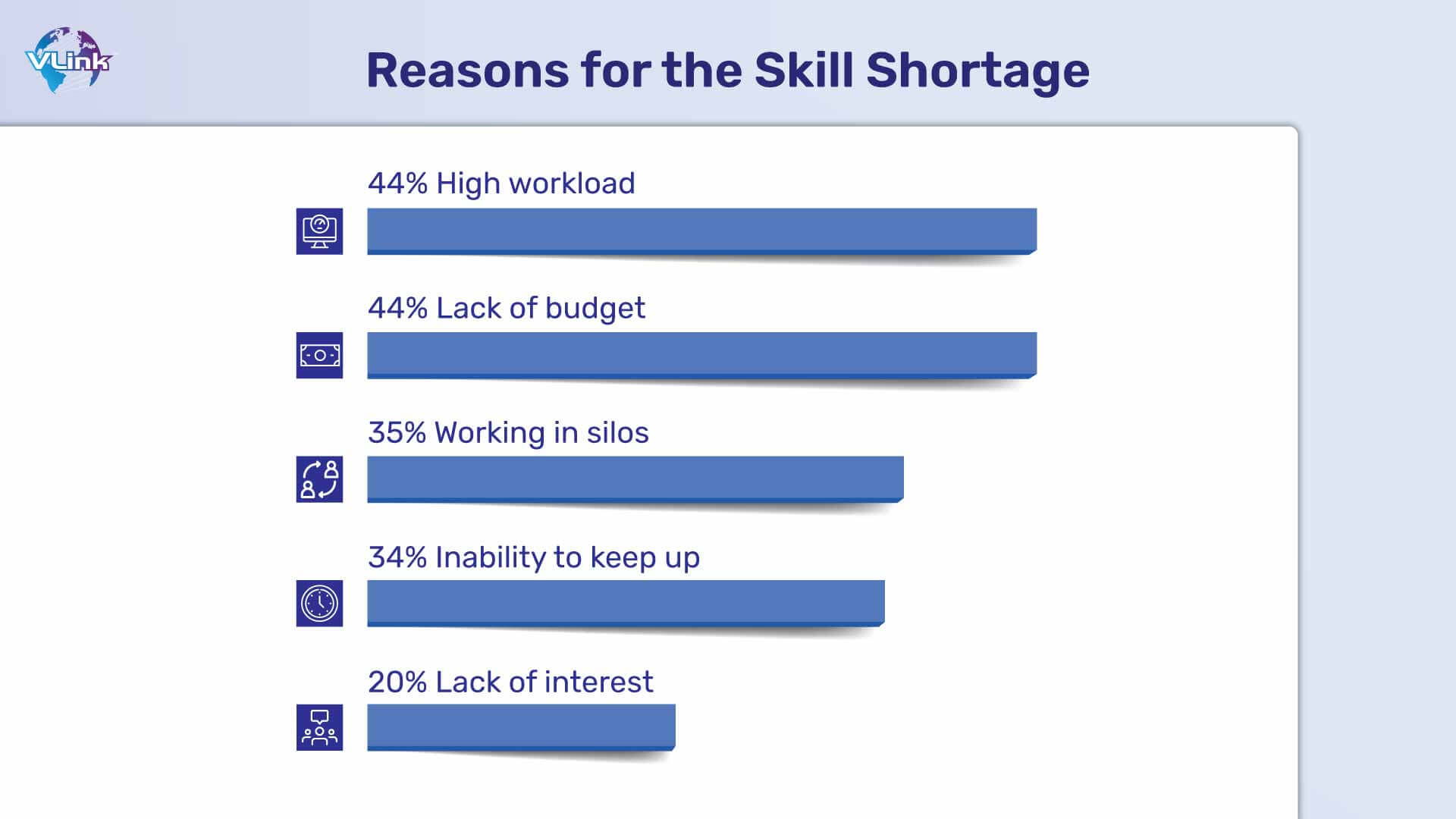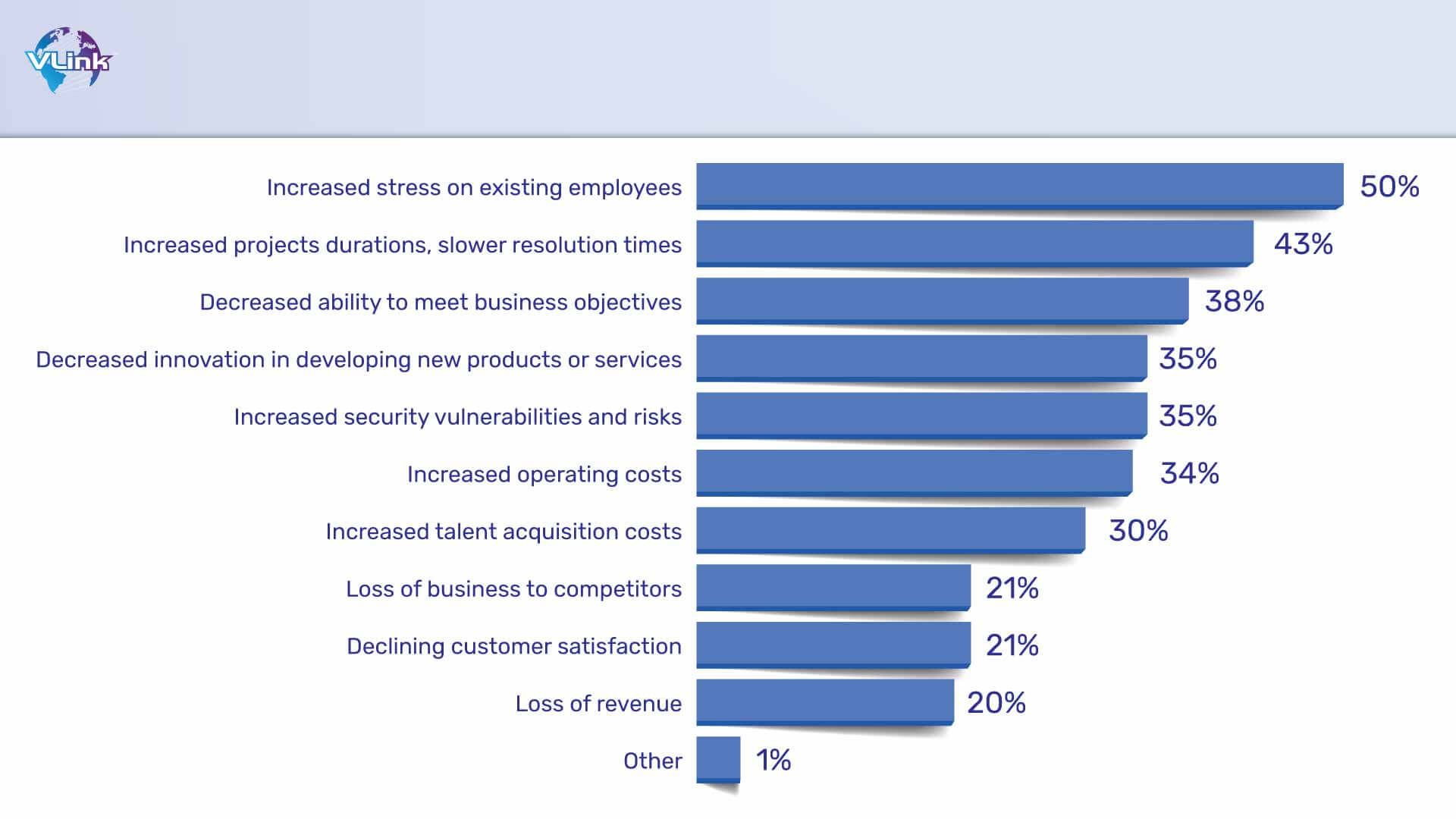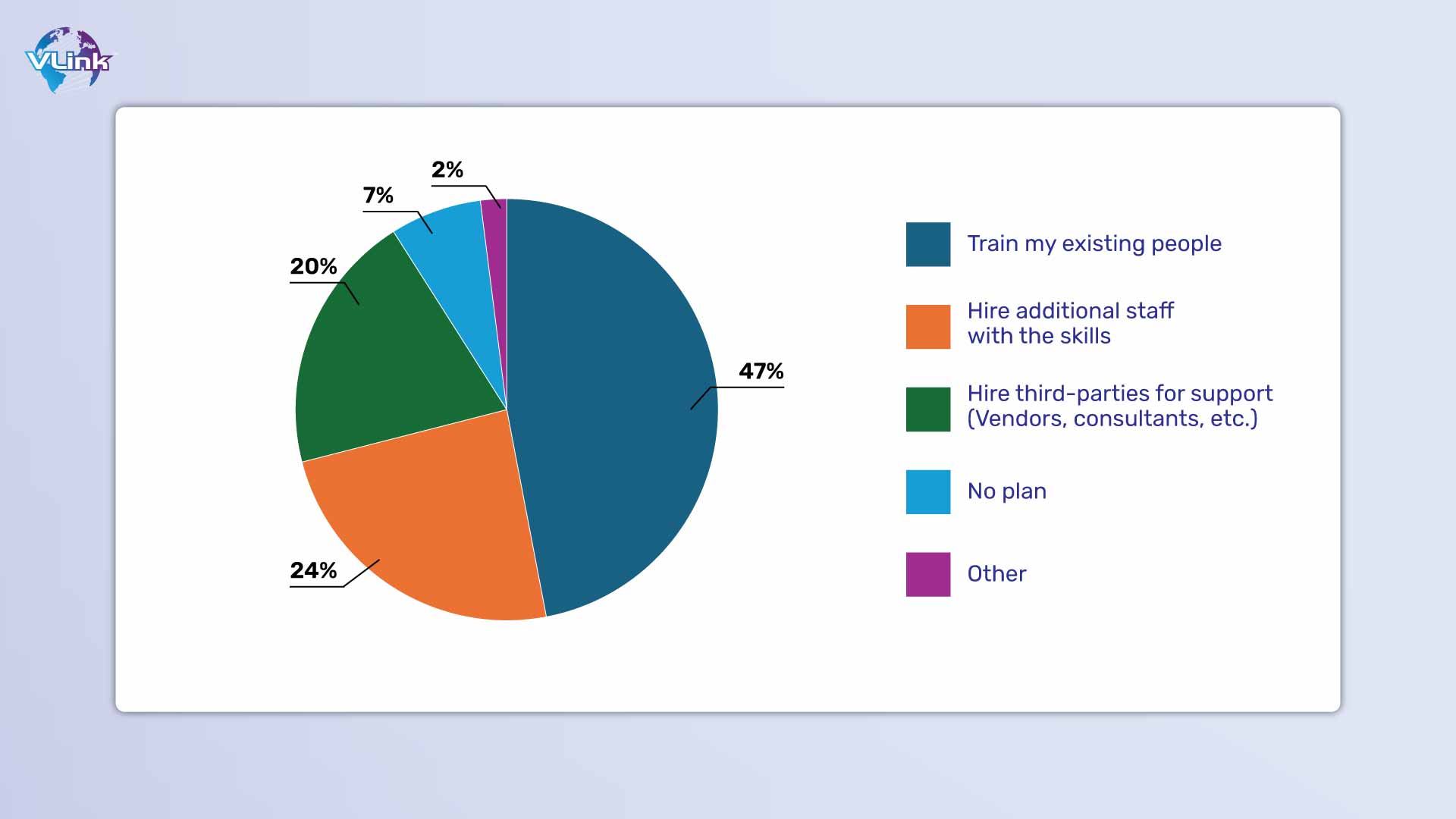In today's ever-evolving world, the demand for IT talent continues to increase. And business owners are constantly looking for skilled professionals.
As industries rapidly progress, the most important issue emerges – the skills gap. This condition, where employees' abilities fail to align with the needs of employers, has increased discussions about future work.
94% of executives say there is a noticeable skills gap in the U.S. workforce. op IT skills gap areas are shown in below figure:

Are you dealing with the same challenges of IT skill gaps? Don't worry! In this blog, we will explore tips and strategies to bridge or address the IT skill gap in your workforce.
Let's first start with its basic definition and critical facts.
What is the IT Skill Gap?
The IT skills gap means the difference between employers' desired levels of technical skills and employee ability. The importance of this gap is getting more popular, especially in areas including automation, cloud computing, big data analytics and artificial intelligence (AI).
Tech Skill gaps lead to enhanced stress, long project durations, and higher operating costs.

So, businesses must follow effective strategies for bridging the gap between desired levels of professionals.
Key Facts of IT Skills Gap
- Assessing the IT skills gap is tough when under half of organizations effectively self-assess - 44%.
- 27% of companies that often struggle are more likely to be outside the IT industry and business managers.
The Impact of IT Skills Gap on Businesses

#1 - Difficulty in finding top talent
With the fast-paced progression of technology, the demand for skilled IT talent often overtakes the supply. Thus, businesses need help finding top candidates to fill critical roles. It leads to longer recruitment cycles and increased costs associated with hiring.
#2 - Reduced productivity and innovation
Businesses with a shortage of employees processing essential IT skills might need help in effectively adopting new technologies or increasing the potential of existing ones.
As a result, it could hamper productivity and innovation within the organization as employees may need help to harness the power of technology.
#3 - Increased operational costs
The challenge of finding skilled IT experts might force organizations to outsource specific tasks or projects to external vendors. Thus, it leads to higher costs than an in-house team. In addition, investing in training programs to fill the skill gap could impose extra expenses in terms of both time and resources.
#4 - Cybersecurity vulnerabilities
The IT skills gap can leave businesses vulnerable to cybersecurity threats. Without skilled cybersecurity professionals to implement robust security measures and protocols, companies may be more susceptible to data breaches, hacking attempts, and other cyberattacks.
#5 - Impact on customer satisfaction
In the tech or IT industry, the IT skills gap can directly affect customer satisfaction.
For example:
A company's poorly designed website or mobile app due to a lack of skilled IT talent can lead to a negative customer experience. As a result, it potentially drives customers away.
How do We Address the IT Skills Gap?
Here are six strategies for recruiting top IT talent and for addressing the IT skills gap:
#1 - Tap into diverse talent pools
One of the more valuable ways to address the skills gaps within your business is tapping into diverse talent pools. It means hiring employees' older adults with the required skills and experience, building a fair hiring process for people with disabilities and considering recruiting worldwide talent.
#2 - Tweak the recruitment process
If you've identified skills gaps within your workplace, consider revising your typical recruitment approach. Prioritize skills and capabilities needed for the position, emphasizing intangible skills and providing ample opportunities for candidates to share their stories and exhibit their personalities.
Value candidates' eagerness to learn and their potential, aiming for employee retention and satisfaction. Emphasize diversity in hiring, being receptive to nontraditional candidates, and approaching diversity considerations from various perspectives.
#3 - Revise the hiring process
Along with your recruitment process, you need to revise your hiring process if you're noticing skills gaps in the workplace. Implement innovative hiring practices such as skills-based assessments, gamified assessments, and blind hiring techniques.
Go with tools and software that properly provide you with the correct information and candidates. Taking time to go through software slowly and with attention to detail will help you identify top IT talent to onboard your team.
#4 - Offer efficient onboarding
Providing a comprehensive onboarding process is another way to fill the IT skill gap in the workplace. This program includes training, mentoring, and resources customized to individual employee needs. It will help you find new hires quickly and fill any skill gaps they may have.
#5 - Create a workplace strategy
Creating an effective workplace strategy can be a very effective way of addressing IT skill gaps. A strategic plan that aligns organizational goals with workforce needs can help identify skills gaps and focus areas for software development. It may include building teams, reallocating resources, or investing in technology to automate tasks.
#6 - Review the gap regularly
It's a good idea to review your IT skill gap analysis monthly. It can help you track progress and drive accountability. Conducting regular assessments of workforce skills and performance metrics can help track progress, identify emerging skill gaps, and adjust strategies accordingly.
This ongoing review process ensures that organizations remain agile and responsive to changing market demands.
Challenges of Addressing or Bridging the IT Skill Gaps

Addressing IT skill gaps presents several challenges that organizations must navigate effectively:
- Rapid Technological Advancement
- High Demand for Specialized Skills
- Cost of Training and Development
- Retention of Skilled Employees
- Global Competition for Talent
Navigating these challenges requires a strategic approach to talent management, continuous learning and development initiatives, effective recruitment and retention strategies, collaboration with educational institutions, and a commitment to diversity and inclusion.
Overcome IT Hiring & Skill Gap Challenges with VLink!
VLink is a leading IT staffing company with a large talent network and a rigorous pre-vetting process. We will help you address IT hiring and skill gap challenges effectively. Leveraging our expertise, we can access a diverse pool of skilled professionals, saving time and resources.
In addition, we offer flexibility, enabling organizations to scale up or down according to project demands. With deep industry knowledge, our dedicated development team provides customized solutions, bridging the skill gap efficiently.
Hiring developers from us will empower businesses to stay competitive in the rapidly evolving tech landscape while focusing on core objectives.
Frequently Asked Questions
The key factors contributing to the skills gap include rapid technological advancements requiring new skills, inadequate education and training systems, evolving job requirements outpacing workforce capabilities, and demographic shifts leading to mismatches between available skills and job demands.
Identify skills gaps by conducting thorough assessments of job requirements versus employees' competencies, gathering feedback from supervisors and employees, analyzing performance data, soliciting input from HR, and utilizing surveys or interviews to understand where deficiencies lie in meeting organizational objectives.
To find a dedicated development team, explore reputable outsourcing platforms, attend industry events, ask for referrals, review portfolios, conduct interviews, and assess communication and project management skills. Ensure alignment with your project's requirements, budget, and cultural fit.








